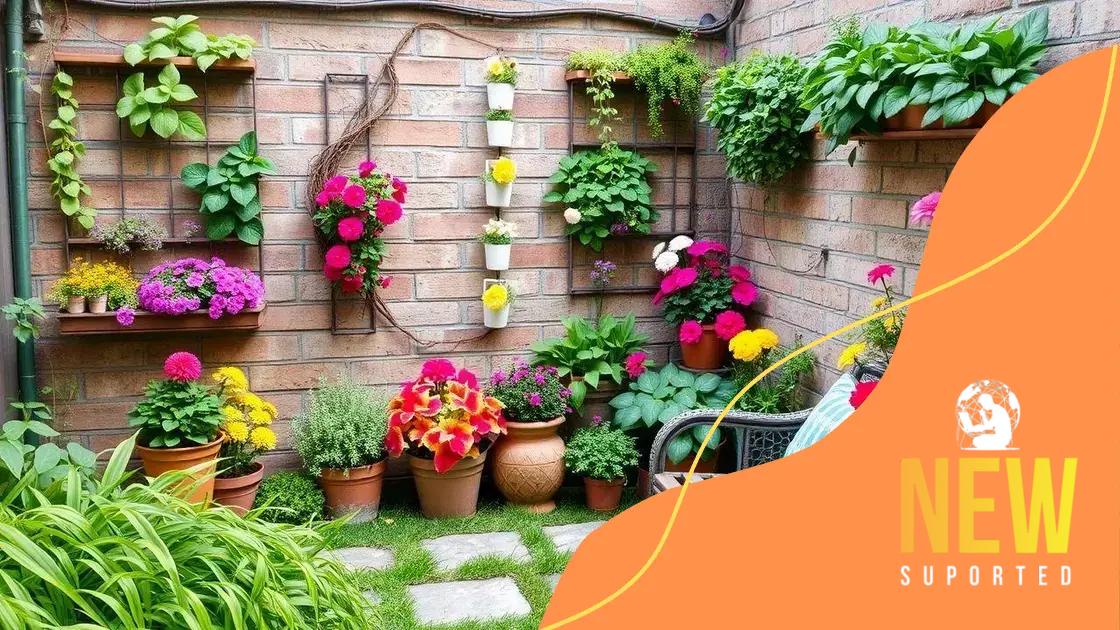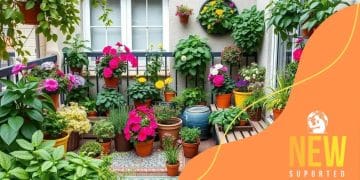How to make the most of garden space in a small yard

To make the most of garden space in a small yard, utilize vertical gardening, create functional zones, use containers effectively, and incorporate aesthetic features to enhance beauty and productivity.
How to make the most of garden space in a small yard can seem like a daunting task. Yet, with a bit of creativity and planning, even the tiniest yard can be transformed into a lush retreat. Let’s explore some practical tips that can help you maximize your space.
Choosing the right plants for small gardens
Choosing the right plants for your small garden can greatly impact its beauty and functionality. By selecting plants that thrive in limited spaces, you can create a vibrant atmosphere without overcrowding.
Consideration of Space
When choosing plants, it’s essential to consider how much space each one will need. Some plants grow wide or tall, which might not be ideal for your area. Opt for compact varieties that allow for a more spacious feel. Additionally, look for species that can provide vertical growth to make the most of your vertical space.
Best Plants for Small Gardens
- Herbs – Plants like basil, thyme, and parsley can flourish in small pots and provide fresh flavors.
- Annual flowers – Marigolds and petunias bring color and can be easily moved around.
- Succulents – Their unique shapes require minimal care and thrive in smaller containers.
- Climbing plants – Vines like sweet pea can enhance vertical space while adding charm.
It’s also beneficial to select plants that bloom at different times of the year. This way, your small garden can remain lively throughout the seasons. For instance, consider mixing early bloomers with late bloomers to extend your garden’s visual appeal.
Another effective strategy is using native plants. These plants are adapted to your local climate and soil, which often means they require less water and maintenance. They also attract local wildlife, adding even more life to your small garden.
Think about the colors and textures too. A mix of plants with varying foliage color and leaf shapes can provide interest and make the space feel inviting. Layering plants with heights ranging from low ground covers to taller blooms helps create depth.
Incorporating these tips will ensure you choose the right plants for your small garden, maximizing both aesthetics and enjoyment. Remember, a well-planned plant selection can transform your limited space into a beautiful retreat.
Vertical gardening techniques to maximize space
Vertical gardening techniques can dramatically maximize space in a small yard. By growing upwards rather than outwards, you can make your small garden feel larger and more vibrant.
Why Choose Vertical Gardening?
Vertical gardening is not only about saving space; it also brings a unique beauty to your garden. This method allows for better air circulation and sunlight exposure, which can lead to healthier plants. Utilizing walls, trellises, and other supports, you can create a visually stunning display.
Types of Vertical Gardens
- Wall planters – These are containers attached directly to walls, perfect for herbs and small flowers.
- Trellises – Use these for climbing plants like beans or cucumbers, which can grow tall and provide shade.
- Pallet gardens – Repurposing wooden pallets offers a rustic look and can support a variety of plants.
- Hanging pots – You can suspend pots from hooks or ceilings to add layers of greenery.
To start, choose a sturdy support for your vertical garden. Ensure it can hold the weight of the plants you intend to grow. Next, select the right plants; vining plants and those that spread out are excellent choices. Additionally, consider planting flowers that attract pollinators, making your garden not only beautiful but also beneficial for local wildlife.
Watering and maintenance can be different for vertical gardens. Be sure to check that each plant receives enough moisture. In many cases, you may need to ensure that water drains properly to avoid root rot. Regularly pruning your plants can help maintain their health and encourage growth.
Adding decorative elements, such as colorful pots or garden art, enhances the aesthetic appeal of your vertical garden. This creates a lively atmosphere that draws attention and invites you to enjoy your small space even more.
Creating functional garden zones

Creating functional garden zones is an effective way to utilize every corner of your small yard. By dividing your garden into specific areas, you can enhance its productivity and aesthetic appeal.
Identifying Zones
The first step is to identify different zones based on their intended use. For instance, you may have a cooking zone with herbs and vegetables, a relaxation zone with comfortable seating, and a play area for kids. Each zone should serve a distinct purpose while contributing to the overall harmony of your garden.
Benefits of Functional Zones
- Efficient use of space – By designating specific areas, you maximize the available space.
- Improved organization – Clear zones help keep your garden tidy and reduce clutter.
- Enhanced functionality – Tailoring each zone to its use makes activities more enjoyable, such as dining or gardening.
- Increased biodiversity – Different plants can thrive in their respective zones, attracting various pollinators.
Consider integrating pathways between zones to create smooth transitions. Use stones, mulch, or stepping stones to define these areas while making it easy to navigate your garden. Lighting can also play a crucial role; string lights or solar lamps can illuminate pathways, adding ambiance and functionality for evening gatherings.
In a cooking zone, planting herbs like basil or rosemary nearby the kitchen can provide convenience and freshness. In a relaxation space, incorporating features like a small water fountain or a fire pit can create a serene atmosphere. Choose comfortable seating, such as garden benches or lounge chairs, to invite relaxation.
Finally, consider the visual appeal of each zone. Selecting plants with differing heights, textures, and colors will not only attract the eye but also enhance the overall experience of your garden. Use decorative elements like garden sculptures or planters to emphasize each zone’s function.
Using containers effectively in limited areas
Using containers effectively is a smart way to maximize limited garden spaces. Containers allow you to grow plants anywhere, from patios to balconies, making them versatile.
Types of Containers
There are many types of containers to choose from. You can use traditional pots, hanging baskets, or even repurposed items like wooden crates or old wheelbarrows. Each type can serve different functions in your small yard.
Benefits of Container Gardening
- Mobility – You can easily move containers to catch sunlight or for aesthetic appeal.
- Soil control – Containers allow you to use the best soil mix suitable for specific plants.
- Space-saving – Vertical spaces can be utilized by stacking or arranging containers creatively.
- Decorative options – Containers can add color and style to your garden.
When planning your container garden, consider the size of each container. Larger containers can hold bigger plants and retain moisture better, while smaller containers are ideal for herbs or flowers. Be sure to use high-quality potting soil to provide essential nutrients for your plants.
Group containers together based on their water and light needs. This will make it easier to care for them. Additionally, adding a layer of mulch on top of the soil in your containers can help retain moisture and suppress weeds.
Don’t forget about drainage. Ensure each container has proper drainage holes to prevent water from standing, which can lead to root rot. You can also use rocks or gravel at the bottom of containers to improve drainage.
Lastly, be creative with the layout of your containers. You can create tiered arrangements or hanging displays to draw the eye upward. This not only saves space but also adds depth to your garden.
Incorporating garden features for aesthetics
Incorporating garden features for aesthetics can transform your small yard into a beautiful oasis. By adding unique elements, you not only enhance the visual appeal but also create inviting spaces.
Types of Aesthetic Features
There are several types of features you can use to elevate your garden’s beauty. Consider adding elements like garden sculptures, water features, or decorative pathways. Each feature serves not just a functional purpose but also adds to the charm of your garden.
Benefits of Aesthetic Features
- Enhanced beauty – Decorative elements can complement the natural beauty of your plants.
- Increased enjoyment – A visually appealing garden encourages you and others to spend more time outdoors.
- Creative expression – Integrating unique features reflects your personal style and creativity.
- Added value – A well-designed garden can increase property value, making it more attractive to potential buyers.
Water features like small fountains or ponds not only add tranquility but also attract wildlife. Birds and butterflies are drawn to these water sources, providing natural beauty and an opportunity for enjoyment. When placing a water feature, keep it in a visible location to maximize its impact.
Additionally, thoughtful pathways made from stones, bricks, or mulch can guide visitors through your garden. They can delineate different zones and create a sense of flow. Lighting along these pathways can enhance their aesthetic appeal at night, creating an enchanting ambiance.
Another option is to use garden decorations such as colorful pots, trellises, or arbors. These can break the monotony and introduce color and texture. Incorporate seasonal decorations that change with the time of year to keep your garden fresh and interesting.
Lastly, consider the placement of these features. Create focal points that draw the eye and lead to other areas of your garden. This approach will encourage exploration and make the overall space more engaging and enjoyable.
FAQ – Frequently Asked Questions about Maximizing Garden Space
What is vertical gardening and how can it help my small yard?
Vertical gardening involves growing plants upwards using supports like trellises or wall planters, which saves ground space and adds visual interest.
How do I create functional zones in my garden?
You can create functional zones by designating specific areas for activities like cooking, relaxing, or playing, allowing for better organization and enjoyment.
What types of containers are best for small gardens?
The best containers for small gardens include pots, hanging baskets, and repurposed items like crates, providing versatility and style.
How can I incorporate aesthetic features into my garden?
You can enhance your garden’s beauty by adding features like sculptures, water elements, and decorative pathways that draw the eye and create a delightful atmosphere.






